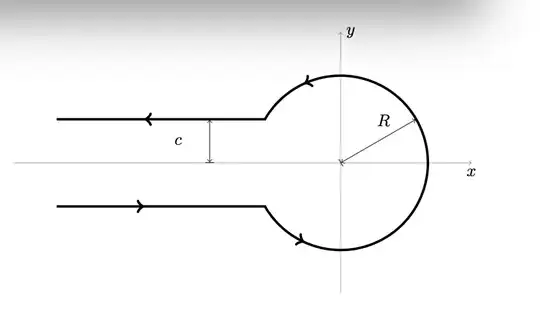This question appears in a set of old qualifying exams I am using to practice.
The Hankel path $H(c,R)$ is an infinite path that starts at a point at infinity $-\infty - ic$ to a point on a circle of $C_R$ radius $R$ ($0<c<R$) centered at the origin along the line $y=-c$, continuing along the an arc on $C_R$ to a point on the line $y=c$, and then to the point at infinity $\infty+ic$ along the line $y=c$.
The problem asks us to show that the Bessel function $J_\nu$ of order $\nu\in\mathbb{C}$ can be expressed as $$ J_\nu(z)=\frac{1}{2\pi i}\oint_{H(c,R)}\lambda^{-\nu-1}e^{\frac12 z\left(\lambda-\frac1\lambda\right)}\ d\lambda,\qquad \mathfrak{R}(z)>0$$
In the first part of the problem, we prove that the Gamma function satisfies $$ \Gamma(z)=\frac{1}{2 i\sin(\pi z)}\oint_{H(c,R)}\lambda^{z-1} e^\lambda\ d\lambda, \qquad z\in\mathbb{C}\setminus\mathbb{Z}.$$
Using this in combination with Euler's reflection formula $\Gamma(z)\Gamma(1-z)=\frac{\pi}{\sin \pi z}$ gives $$\frac{1}{\Gamma(z)}=\frac{1}{2\pi i}\oint_{H(c,R)}\lambda^{-z}e^\lambda \ d\lambda \qquad z\in\mathbb{C}.$$ Using Cauchy's integration theorem, we also have that the formulas above are independent of $c$ and $R$, i.e. we can deform $H(c,R)$ to any other Hankel path $H(c',R')$.
This allows us to rewrite $J_\nu$ as $$J_\nu(z)=\sum^\infty_{n=0}\frac{(-1)^n}{n!\Gamma(n+\nu+1)}\Big(\frac{z}{2}\Big)^{\nu+2n}= \frac{1}{2\pi i}\sum^\infty_{n=0}\frac{(-1)^n}{n!}\Big(\frac{z}{2}\Big)^{2n+\nu}\oint_{H(c,R)}\lambda^{-\nu-n-1}e^\lambda \ d\lambda.$$ By analytic continuation, it suffices to assume $z>0$. A change of variables $\lambda=\frac12 zw$ deforms $H(c,R)$ to $H(2z^{-1}c, 2z^{-1}R)$. This change of variables, provided that order of summation and integration can be inverted, gives $$J_\nu(z)= \frac{1}{2\pi i}\oint_{H(2z^{-1}c,2z^{-1}R)}\sum^\infty_{n=0}\frac{(-1)^n}{n!} \Big( \frac{zw^{-1}}{2}\Big)^n w^{-\nu-1}e^{\frac12 zw} \ dw.$$ The desired formula follows easily from this (Cauchy integration type arguments allow us to deform the path $H(2z^{-1}c,2z^{-1}R)$ back to $H(c,R)$).
Problem: I am having trouble justifying the change in the order of summation and integration. I am trying to use dominated convergence type of arguments but I am not getting very far. Any hints are appreciated. Thanks!
